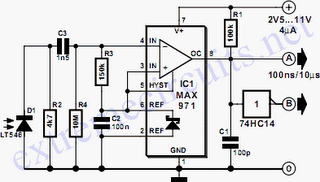Home » Circuits
Infra-Red Sensor/Monitor
The sensor/monitor shown in the diagram ‘wakes up’ the host system on detection of infra-red (IR) signals. It draws so little supply current that it can remain on continuously in a notebook computer or PDA device. Its ultra-low current drain (4µA maximum, 2.5µA typical) is primarily that of the comparator/reference device, IC1. The circuit is intended for the non-carrier systems common in infra-red Data Association (IrDA) applications. It also operates with carrier protocols such as those of TV remote controllers and Newton/Sharp ASK (an amplitude shift keying protocol developed by Sharp and used in the Apple Newton). The range for 115,000-baud IrDA is limited to about 6 in (15 cm), but for 2400-baud IrDA, it improves to more than 12 in (30 cm). Immunity to ambient light is very good, although bright flashes usually cause false triggers. To handle such triggers, the system simply looks for IR activity after waking and then returns to sleep mode if none is present. The sensor shown, D1, a relatively large-area photo-diode packaged in an IR-filter material, produces about 60µA when exposed to heavy illumination, and 400mV when open-circuited. Most photo-diodes may be used. Operation is in the photovoltaic mode without applied bias.
The range for 115,000-baud IrDA is limited to about 6 in (15 cm), but for 2400-baud IrDA, it improves to more than 12 in (30 cm). Immunity to ambient light is very good, although bright flashes usually cause false triggers. To handle such triggers, the system simply looks for IR activity after waking and then returns to sleep mode if none is present. The sensor shown, D1, a relatively large-area photo-diode packaged in an IR-filter material, produces about 60µA when exposed to heavy illumination, and 400mV when open-circuited. Most photo-diodes may be used. Operation is in the photovoltaic mode without applied bias.
This mode is slow and not generally used in photo-diode circuits, but speed is not essential here. The photovoltaic mode simplifies the circuit and saves a significant amount of power. In a more conventional configuration, for instance, photo-conductive, photo currents caused by ambient light and sourced by the bias network would increase the quiescent current about ten times.
